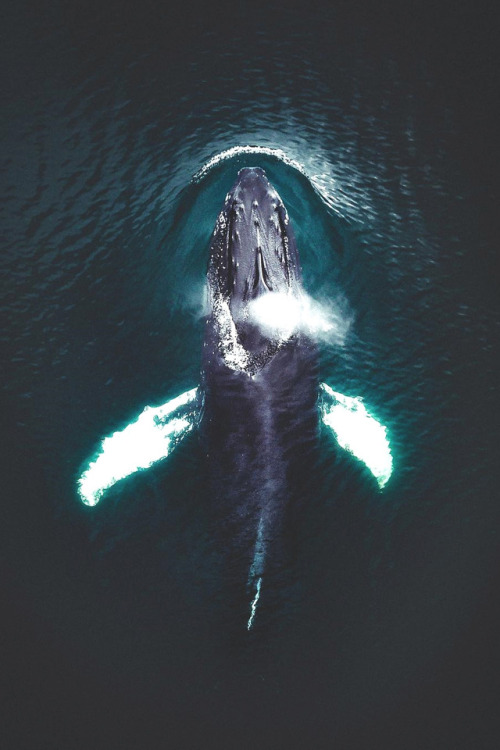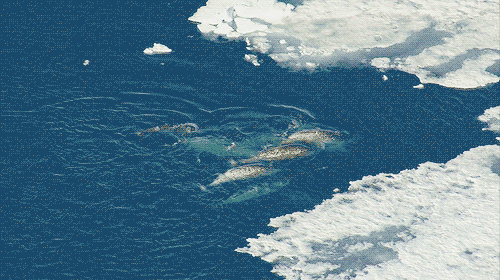Dinoflagellates The Dinoflagellates Are A Large Group Of Flagellate Protists. Most Are Marine Plankton,

Dinoflagellates The dinoflagellates are a large group of flagellate protists. Most are marine plankton, but they are common in fresh water habitats as well. They are characterized by two flagella, one girdling the cell and the other trailing the cell. Some dinoflagellates exist in coral, in a symbiotic relationship. These dinoflagellates are termed the zooxanthellae. Other dinoflagellates occur in such high numbers that the water is colored red, a phenomenon known as a red tide.
More Posts from Simplyphytoplankton and Others







Underwater creatures: Photographer Marty Snyderman captures unique behaviors
Underwater photographer Marty Snyderman’s fascinating body of work brings to life some of the more unique behaviors of the animals of the deep. Snyderman has dedicated his professional life to documenting these creatures — including those that clean other fish, guard fertilized eggs in their mouths, and “fish” for their dinner using a natural worm or fishlike lure incorporating their own body as a fishing rod. In order to find such intriguing creatures, Snyderman, 67, said a lot of discussion must first take place between himself and fishermen, scientists, photographers or even local diving instructors. When photographing his subjects, he tries to stay within one or two feet of them whenever possible, something he admits can be tricky, given the sensitivity of the fish, whales, manta rays and other subjects. (Caters News)
Photography by Marty Snyderman
See more photos of underwater creatures and our other slideshows on Yahoo News.

For two years, the Bering Sea has been largely without winter ice, a development scientists modeling the warming impacts of greenhouse-gas pollution from fossil fuels once forecast would not occur until 2050.
This ice provided a giant platform for growing algae at the base of the food chain, and has been a significant contributor to the remarkable productivity of a body of water, stretching from Alaska to northeast Russia, that sustains some of the biggest fisheries on the planet.

“I make sure that when I am boating that nothing goes into the water, I try to recycle everything I can, and I don’t eat seafood unless it is invasive lionfish. I also participate in as many coastal cleanups to help to remove all of the garbage along our shorelines and I try to encourage others to do the same. We have a long ways to go in ocean conservation, but national marine sanctuaries, along with national parks, monuments, and wildlife refuges, afford us the best opportunity to help leverage limited resources to address coastal and marine conservation."
– Mark Chiappone, research associate at Nova Southeastern University and assistant professor at Miami Dade College
What inspires you about the ocean?
(Photo: Scrawled filefish in Florida Keys National Marine Sanctuary. Credit: Daryl Duda)
Greta Thunberg, international climate activist.
An icon.





When wood turns into glitter
Many moons ago, in the area that is now Nevada ancient woodlands were living through events that would result in some stunning pieces that grace museums around the world. Some 14 million years ago in the Miocene, the area was thickly forested rather than displaying the arid environment of today. It was also much closer to sea level, since the area has been extensively uplifted since then, due to tectonic stresses caused by the subduction of the Pacific and Farallon plates under the North American one. The area also saw intense subduction related volcanism (ongoing along the USA’s west coast to this day), which periodically covered the forests in silica rich ash. As groundwater interacted with the magma below, weathering the layers of ash into clays, it dissolved silica, precipitating it when conditions such as temperature and pressure changed, replacing the ash covered trees with opal, sometimes so clearly that every cell is visible. While not really suitable for jewellery use due to its tendency to crack as it dries out (called crazing in the trade), these rare logs from the Virgin Valley of Nevada make for stunning collector’s specimens
Keep reading



Daily Life
Weekdays
Weekends
Buses
Food
Daily life here in Costa Rica, at least for me, is not necessarily all that different or much more exciting than daily life in the U.S. The major difference is since my workload is a lot lighter here, I have a lot more free time.
A typical week may play out like this. Every day, I usually get up between 7:30-8:00 am. Even on weekends when I don’t have plans, my body is used to waking up early and I usually never sleep to my alarm. This may be because the sun is always up my 6:00 am and my internal body clock has just adjusted to this. On Monday, I don't have class until 1 pm, but I usually don't get home until 7:30-8:00 pm, which makes Monday my busiest day. I usually spend the first half of the day doing random stuff, unless I have something I need to prepare for a class, such as an exam or presentation. On Tuesday, I have class at 10:00 am until 11:40 am, and I have a break to go back home and eat lunch before I have my other class at 3:00 pm, which usually is a little under two hours.
By Tuesday night, I usually pretty tired (since Monday is always a long day) and I don't do too much since I have no class on Wednesday. This makes Wednesday a day to relax or get a head start on work for Thursday and Friday. Occasionally, I have gone on day trips. For example, one week I went somewhere with my host mom for the day and last week, I went to San José to visit two museums. The rest of my week is really easy class wise, with only one class Thursday and Friday, with both starting at 10:00 am.
On weekends, I've gone on quite a few trips, some sponsored by IFSA and some as a part of a class. Otherwise, I may go a few places with my host parents, do watch, or watch a few things on Netflix.
In order to get around, I usually take the bus. I live in Barva and la Universidad Nacional is in Heredia, so I always need to take the bus to get to and from class. One round trip costs about $0.35, and it can take anywhere from 10-30 minutes for the bus to get from Barva to Heredia or vice versa, but it usually takes about 15-20 minutes. Other buses, to San José for example, cost a bit more, but still under $1 one way usually unless it's a few hour trip. That being said, if you plan out which buses you need to take, it is pretty easy to get around, even if you're used to having a car like me.
With my host family, breakfast usually consists of eggs a mix of rice and beans called gallo pinto. We usually have freshly-squeezed orange juice as well, and my host parents also drink coffee. We sometimes have cereal or an egg sandwich too. Lunch and dinner are usually pretty similar, and almost always include rice and beans (a staple in Costa Rica). Sometimes my host mom needs to make food that's a little bit different for me because I'm a vegetarian. We almost always have either some type of fruit juice, usually made of cas, but sometimes mango, pineapple, or watermelon, or iced tea. I usually like everything my host mom makes. I don't have to do any of my own laundry, which is very different from college in the U.S. If my host mom does not do it, the maid that comes on Mondays and Fridays comes.




North Cascades National Park, Washington
A night in the Cascade Mountains
By a 3-0 vote, the 9th U.S. Circuit Court of Appeals said the government fell short of the “high bar” needed to dismiss the Oregon case, originally brought in 2015 against the administration of President Barack Obama.
Twenty-one children and young adults, ages 11 to 22, accused federal officials and oil industry executives of violating their due process rights by knowing for decades that carbon pollution poisons the environment, but doing nothing about it.
The government contended that letting the case proceed would be too burdensome, unconstitutionally pit the courts against the executive branch, and require improper “agency decision-making” by forcing officials to answer questions about climate change.
But the appeals court said the issues raised “are better addressed through the ordinary course of litigation.”
A trial is scheduled for Oct. 29 in the federal court in Eugene, Oregon.
President Donald Trump’s administration also has asked the U.S. Supreme Court to dismiss the lawsuit or put it on hold, and is awaiting a ruling. Its earlier bid to end the lawsuit failed in March.
-
 kellyrick liked this · 5 years ago
kellyrick liked this · 5 years ago -
 agathethepowerblr-blog reblogged this · 6 years ago
agathethepowerblr-blog reblogged this · 6 years ago -
 agathethepowerblr-blog liked this · 6 years ago
agathethepowerblr-blog liked this · 6 years ago -
 simplyphytoplankton reblogged this · 7 years ago
simplyphytoplankton reblogged this · 7 years ago -
 wanderlustw0lf liked this · 7 years ago
wanderlustw0lf liked this · 7 years ago -
 fireeaglespirit liked this · 8 years ago
fireeaglespirit liked this · 8 years ago -
 miss-miaumiau reblogged this · 8 years ago
miss-miaumiau reblogged this · 8 years ago -
 gaypoptosis liked this · 8 years ago
gaypoptosis liked this · 8 years ago -
 bonesandpoemsandflowers liked this · 8 years ago
bonesandpoemsandflowers liked this · 8 years ago -
 thelostandsureashellnotfound liked this · 9 years ago
thelostandsureashellnotfound liked this · 9 years ago -
 thekimiekimkim reblogged this · 11 years ago
thekimiekimkim reblogged this · 11 years ago -
 piratepicnic reblogged this · 13 years ago
piratepicnic reblogged this · 13 years ago -
 richardisindifferent liked this · 13 years ago
richardisindifferent liked this · 13 years ago -
 alwayskacie reblogged this · 13 years ago
alwayskacie reblogged this · 13 years ago -
 coolcats-gettats-blog reblogged this · 13 years ago
coolcats-gettats-blog reblogged this · 13 years ago -
 firefrenzie-blog reblogged this · 13 years ago
firefrenzie-blog reblogged this · 13 years ago -
 z-z-zannas-ocean-blog reblogged this · 13 years ago
z-z-zannas-ocean-blog reblogged this · 13 years ago -
 bernbutt reblogged this · 13 years ago
bernbutt reblogged this · 13 years ago -
 girlaidan liked this · 13 years ago
girlaidan liked this · 13 years ago -
 imtellingyoujusthowifeel reblogged this · 13 years ago
imtellingyoujusthowifeel reblogged this · 13 years ago -
 polymath4ever reblogged this · 13 years ago
polymath4ever reblogged this · 13 years ago -
 oceanstuff reblogged this · 13 years ago
oceanstuff reblogged this · 13 years ago

Blog dedicted to phytoplankton. Phytoplankton are microscopic organisms that are responsible for half of the photosynthesis that occurs on Earth. Oh, and they look like art... Follow to learn more about these amazing litter critters! Caution: Will share other ocean science posts!Run by an oceanographer and phytoplankton expert. Currently a postdoctoral researcher.Profile image: False Colored SEM image of Emiliania huxleyi, a coccolithophore, and the subject of my doctoral work. Credit: Steve Gschmeissner/ Science Photo Library/ Getty ImagesHeader image: Satellite image of a phytoplankton bloom off the Alaskan Coast, in the Chukchi SeaCredit: NASA image by Norman Kuring/NASA's Ocean Color Web https://earthobservatory.nasa.gov/images/92412/churning-in-the-chukchi-sea
158 posts
